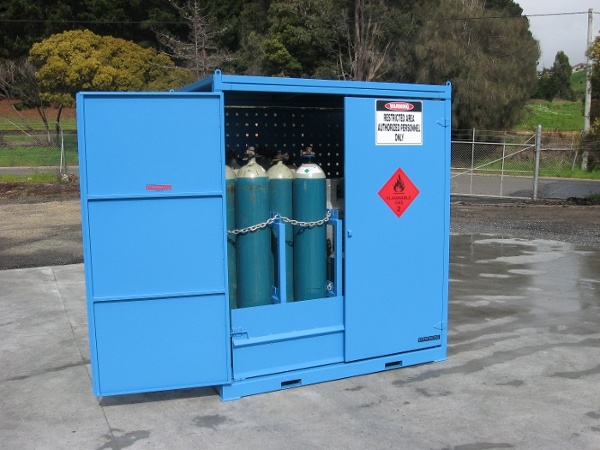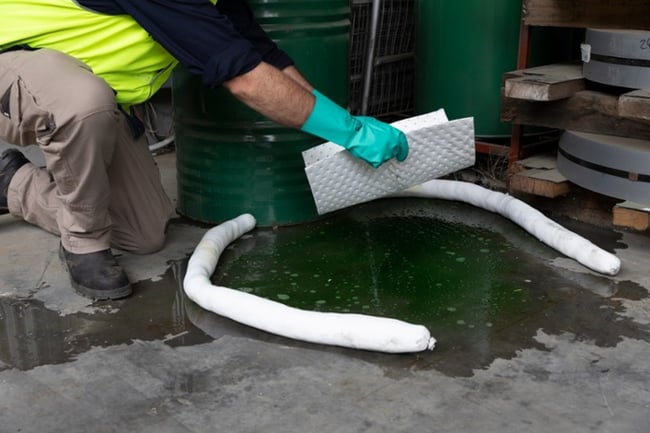When you’re working with dangerous goods, fire risk is a significant consideration that requires strict controls. In this post, we’ll take a deep dive into flammable vapours – what they are, how they present risk and the measures you can take to control them.
What Are Flammable Vapours?
Flammable vapours can ignite and burn in the presence of an ignition source such as a spark, flame or heat. These vapours are typically emitted by volatile liquids or substances and can form explosive mixtures with air within a certain concentration range. When the concentration of flammable vapours in the air reaches this range, any ignition source can trigger a fire or explosion.
Understanding and controlling flammable vapours and ignition risk is crucial for fire safety and hazard prevention. It’s particularly important for any industry using these chemicals including mining, manufacturing, construction, food & beverage, and chemical processing.
REMEMBER: Ignition sources are those items which can product heat, spark or a flame to ignition flammable vapours. Types of ignition sources include commonly known triggers such as lighters or hot surfaces, as well as less obvious examples including mobile phones or electrical work that’s not hazardous area rated.
What Dangerous Goods Emit Flammable Vapours?
Numerous dangerous goods emit flammable vapours. These goods are typically substances that are volatile and can evaporate at regular temperatures – forming vapours that may ignite if an ignition source is present.
Dangerous goods that give off flammable vapours include Class 2.1 Flammable Gases, Class 3 Flammable Liquids, Class 4 Flammable Solids, Division 5.1 Oxidising Agents and Division 5.2 Organic Peroxides.

Many classes of dangerous goods have the ability to produce flammable vapours which may result in a fire or explosion if not properly controlled.
Examples of Substances that Emit Flammable Vapours
Some common examples of dangerous goods that emit flammable vapours include:
- Petroleum products: Petrol, diesel, kerosene and other petroleum-based fuels
- Industrial solvents: Various solvents used in industries such as paint thinners, acetone, toluene, xylene, and methyl ethyl ketone
- Alcohols: Ethanol and other alcohols
- Aerosols: Aerosol cans containing flammable propellants, such as butane or propane
- Liquefied Petroleum Gas (LPG): Propane and butane, commonly used as heating fuels or in portable stoves
- Natural gases: Methane, the primary component of natural gas used for heating and cooking
- Hydrocarbon gases: Gases such as ethylene, propylene and butylene
What is Flashback and Why is it Dangerous?
In addition to fire or explosion risk, flammable vapours may also create ‘flashback’.
Flashback is the ignition of a flammable vapour trail that leads right back to the source; meaning that flammable vapours can create a fire risk – far beyond the general area in which the substance is being used.
It may occur when a flame or combustion front travels backward through a piping system or other equipment, reaching the point of origin, such as an open chemical drum.
As flammable vapours can travel distances (largely undetected), it creates a serious fire and flashback risk that must be controlled to protect people and property.
IMPORTANT: Storemasta Safety Cabinets are equipped with flashback protection. The cabinets offer built in flash arrestors and vent openings for the installation of compliant mechanical ventilation systems, if required.
How Can I Reduce Flammable Vapours in the Workplace?
It's important to handle these dangerous goods with care, following proper storage, transportation, and handling procedures to minimise the risk of fire or explosion due to their flammable vapours.
However, there are some key points to consider when looking at ways to control vapours. These include:
Ventilation Systems
There must always be sufficient ventilation or extraction to ensure airborne contaminants limits stay within the workplace exposure standards (see Safe Work Australia). Flammable vapours not only create a fire risk, but they may be harmful to human health. Therefore, airborne contaminants must be monitored and controlled for health and safety.
Spill Response
The timely identification, containment, clean up and disposal of spilled chemicals is essential for the control of vapour emissions. When substances are spilled or containers of chemicals are left unsecured, flammable vapours will escape, causing fire risk.
Developing a strong spill response suitable for the type of chemical released is essential for the effective control of flammable vapours in the workplace.
Secure Chemical Containers
Make sure that your chemical containers, drums, IBCs and gas cylinders are operating as they should. Leaks and spills will only add to fire risk, so inspect your containers regularly to ensure that they are in good condition.
Usage and Transfer
Where a flammable liquid is being used or transferred in such a manner that vapour is released, the ventilation, extraction, or dispersal provisions shall be sufficient to maintain exposure levels below the exposure standards published by Safe Work Australia.
When transferring or decanting liquids, ensure that dispensing and handling equipment is used by staff to minimise the impact of leaks and spills. Even a small amount of spilled liquid can create flammable vapours that may be ignited.
Correct Storage
Compliant dangerous goods storage designed and constructed for the particular hazard class is an essential measure to control vapours and prevent any hazards associated with incompatible dangerous goods. This may include natural ventilation for gas cages, to disperse any leaked gas. It may also include features such as perforated shelving and self-closing, tight-fitting doors for flammable liquid cabinets, to stop the vapours from spreading throughout the workplace.

If you have the correct storage for your dangerous goods, you can decrease the likelihood of vapours accumulating within the storage area.
Regular Housekeeping
Storage areas must be kept clean, with containers wiped down after use to minimise residues and flammable vapours.
REMEMBER: Any staff who are tasked with handling or storing dangerous goods must be trained to identify and control the hazards. If staff are working with goods that emit flammable vapours, they must be trained to reduce fire risk and any human harm which may be the result of exposure to the vapours.
Control of Flammable Vapours
Proper handling, storage, and ventilation are crucial to minimise the risk of fire or explosion when working with or near substances that produce flammable vapours.
Additionally, in industrial settings, specific safety measures such as explosion-proof equipment and facilities may be necessary to mitigate the risks associated with flammable vapours.
Using hazardous area rated equipment, such as HVAC systems for temperature-controlled stores, can control the risk of fires when storing flammable substances.
-1-1.jpg?width=650&height=433&name=IDL%20(74%20of%20110)-1-1.jpg)
Electrical equipment can be an ignition risk, so seek professional guidance if you are storing substances in an area that could potentially product heat or sparks.
Fire Protection
In addition to the control of flammable vapours, you must ensure that you’re ready to manage an incident if it occurs. This means ensuring:
- Storage is suitably segregated from incompatible substances that may add to fire or explosion risk
- Outdoor storage is installed away from boundaries and protected places
- Greenery is maintained so that it does not overhang flammable chemical stores
- Placarding is installed on the property and in storage and handling areas to raise awareness about the substances on site
- Flammable items, such as lithium-ion batteries, are kept in secure non-combustible storage away from dangerous goods
- Any combustible materials, such as paperwork or rubbish, are not left lying around your workplace or in areas where chemicals are stored or used
- ‘No ignition source’ signage is installed in the appropriate areas
- Fire protection systems are in place
- Emergency plans and procedures are developed with the flammable chemicals considered
REMEMBER: The Australian Standards offers detailed requirements for specific fire protection to suit your dangerous goods class.
Identification and Isolation of Ignition Sources
An ignition source is any agent or mechanism capable of initiating combustion or ignition in a flammable substance or environment. Essentially, it's something that can start a fire or explosion.
Ignition sources can come in various forms, including:
- Electrical: Electrical sparks, arcs, or short circuits can ignite flammable materials, especially in environments with volatile gases or vapours.
- Heat: Heat sources such as flames, hot surfaces, sparks, or friction can provide the necessary energy to initiate combustion.
- Chemical: Certain chemical reactions can generate heat or sparks, leading to ignition in the presence of flammable substances.
- Mechanical: Mechanical impacts, such as crushing, grinding, or cutting, can produce sparks or generate heat that may ignite combustible materials.
Identifying and eliminating or mitigating potential ignition sources is an essential part of risk assessment and safety management practices.
You should also be aware of other fire risks that could further ignite flammable chemicals or flammable vapours, such as bushfires, workplace fires or incidents occurring in your neighbourhood.
Flammable Safety
To learn more about protecting your business from fire and explosion, compliant storage is a must. Read our popular eBook, Essential Considerations When Storing Flammable Liquids Indoors, to learn more about the steps you can take to successfully minimise the likelihood of flammable vapours sparking a fire. Grab your copy now to find out more.

Living life by the 4 C’s of marketing – communication, coffee, compliance… and more coffee – Leisa Andersen is Storemasta’s Content Marketing Manager. When she’s not writing, you’ll find her enjoying all the good things in life, including shopping, travel and gluten free donuts.


